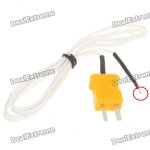I've actually looked into this cause I thought it would be nice to make my own data logging LPM. Was inspired by the 2.5W Laserbee

Hate to say it guys but this thing couldn't come close.
2degree range on that dude is way too terrible of accuracy. Almost to cheap to even use as a temperature reader! This is especially the case for the precision we would want. Say you want.... -+1mW resolution you would need a device that would raise to 2000C per W .... and i'd have a max of a 1W resolution(unless you don't mind going to 4000C per w...) However, there could be a few problems at 2000C =P... and not to mention the fact that the meter can't read that high. Something like this perhaps could work as a terrible measuring device for 5-50W range devices at best.... So all of you that have those go ahead and try it out =/




